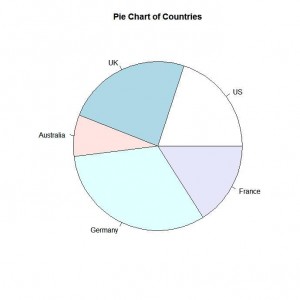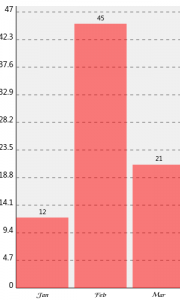-
Simple Pie Chart
Script
1 2 3 | slices <- c(10, 12,4, 16, 8) lbls <- c("US", "UK", "Australia", "Germany", "France") pie(slices, labels = lbls, main="Pie Chart of Countries") |
Output

Continue reading
Script
1 2 3 | slices <- c(10, 12,4, 16, 8) lbls <- c("US", "UK", "Australia", "Germany", "France") pie(slices, labels = lbls, main="Pie Chart of Countries") |
Output

Continue reading
注意:请将代码中的“》”(中文全角)全部替换为“>”(英文半角)。
代码:
1 2 3 4 5 6 7 8 9 10 11 12 13 14 15 16 17 18 19 20 21 22 23 24 25 26 27 | #!/use/bin/perl use SVG::TT::Graph::Bar; my @fields = qw(Jan Feb Mar); my @data_sales_02 = qw(12 45 21); my $graph = SVG::TT::Graph::Bar-》new( { 'height' =》 '500', 'width' =》 '300', 'fields' =》 @fields, } ); $graph-》add_data( { 'data' =》 @data_sales_02, 'title' =》 'Sales 2002', } ); open( my $fh, '》', "bar.svg" ); select $fh; binmode $fh; print $graph-》burn(); close($fh); |
输出:

Continue reading
《Building Bioinformatics Solutions with Perl, R and MySQL》(P162-163)……【阅读全文】
第一步:整理基因组坐标格式。
把基因组坐标整理为如下格式,保存到一个纯文本文件中。……【阅读全文】
《Perl Programming for Biologists》以生物学中的实际例子来讲解Perl,循序渐进。全书共设3大部分:初级、中级与高级,有11个章节,内容除涉及标量、数组、散列、循环控制、子例程、文本处理、输入输出、模块等基本内容外,还专门讲解了参考、面向对象的编程以及Bioperl等生物信息学中经常遇到的内容。
虽然是英文版的,但英文非常简单,大多数时候可以流畅阅读。当然,还是建议至少看完一遍小骆驼之后再来看此书。
PS:书中有不少错误,阅读的时候一定要注意奥。……【阅读全文】
棕色眼睛是显性,蓝色眼睛是隐性。
色觉是显性,色盲是隐性。
头发浓密是显性,秃顶是隐性。
卷起舌头是显性,无法卷起舌头是隐性。
多指是显性,五指是隐性。(注:看到这条时,多少有点惊讶。)……【阅读全文】
推荐一个讲解遗传学基础的网页:Genetics Primer。
全文不是很短,但讲解简单明了,非常容易理解,很快就可以看完(如果你对遗传学一无所知,那就另当别论了)。……【阅读全文】
How to get a paper published – 关于论文发表(原文及译文)
After you have followed all the advices on how to write a paper, had it submitted to a journal of your choice, here are things you should do:
1. If the editor and the journal are established and responsible, you should receive an acknowledgement within two weeks. Otherwise, you should post an inquiry. Manuscripts do get lost at times.
Get every new post delivered to your Inbox
Join other followers